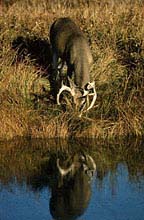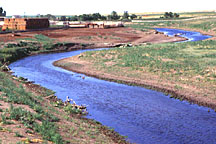| Français | Contact Us | Help | Search | Canada Site | |||||
| AAFC Online | Links | Newsroom | What's New | Site Index |
| PFRA Online | Staff | Programs & Services | Offices | ||||
Prairie Farm Rehabilitation Administration |
||||||||
|
|
||||||||
| |
Riparian areas: an undervalued Saskatchewan resourceWhat is a riparian area?
The province's riparian areas naturally support a dense growth of moisture- loving grasses and shrubs such as willow, wild rose, Saskatoon, and chokecherry. Trees commonly found in riparian areas are Manitoba maple, green ash, cottonwood, trembling aspen and balsam poplar.  Although riparian zones often represent only a small percentage of the land in a watershed, they are vitally important because of the diversity of plants and animals they support. Riparian areas are considered among the most productive ecosystems in the world. Proper management yields many benefitsThe sign of a healthy riparian area is dense, thick vegetation. This is achieved through good management of the entire area. Effective riparian management produces a range of environmental and economic benefits. ENVIRONMENTAL BENEFITS
Properly managed riparian areas support dense vegetation which: Controls shoreline erosionThe root systems of riparian vegetation stabilize soil along the shorelines of rivers, creeks,
lakes, sloughs and potholes. This vegetation minimizes shoreline erosion damage caused by ice
scouring and fast flowing flood waters.
Maintains water qualityDense vegetation filters soil particles, agriculture chemicals, and organic or commercial
fertilizers from farmland run-off water. Riparian plant communities bordering streams and rivers
shade the water, decreasing temperature and increasing water purity by inhabiting algae
growth.
Reduces flood peaks/recharges groundwaterDense vegetation traps snow during the winter. In the spring the snow, shaded by riparian
vegetation, melts slowly, increasing the amount of water that soaks into the soil. This slow melt
enhances surface moisture and replenishes groundwater reserves, while reducing erosion
damaged caused by flooding.
Provides wildlife/fish habitatDense vegetation is very important to many species of wildlife. They come for water,
food, cover and relief from weather extremes.
Riparian areas provide critical habitat for deer, moose, elk and pronghorn antelope. The dense trees and shrubs shelter pathways used by these animals as they move to other habitats. Many of Saskatchewan's birds depend on riparian habitats during some period in their life cycle. Fish depend on healthy riparian conditions. Dense vegetation filters agriculture run-off, resulting in pure, clear water. Water of this quality is necessary to support the plant and insect life that many aquatic animals, such as fish, turtles and frogs, require for food and cover. Economic BenefitsThe following benefits are realized in properly managed riparian areas. 
Properly managed riparian vegetation reduces the speed of water flow, allowing more water to enter the soil and move down into groundwater storage. Livestock productionWithin a planned grazing system, riparian areas can provide a reliable supply of quality
forage and shelter animals during weather extremes.
Crop productionRiparian areas recharge groundwater reserves that can benefit annual crops and forages
throughout the growing season.
Water supplyRecharged groundwater reserves maintain water levels in dugouts and wells used by
livestock and people.
Timber harvestingRiparian areas can provide a sustainable supply of wood for use as fuel or lumber.
TrappingRiparian areas are attractive habitat for many fur-bearing species of wildlife, including
beaver, mink, muskrat and raccoon.
Tourism/recreationPopular recreation sites for picnicking, camping, hunting, fishing and wildlife watching
are provided.
Real estateRiparian areas offer premium living conditions for people who enjoy the close proximity
of lush vegetation, natural water and wildlife.
The problem of declining productivityCauseIntensive cropping practices, overgrazing by livestock, channelization and clearing of rivers and creeks, timber harvesting, sand and gravel removal, and harmful recreation activities to destroy the dense vegetation in riparian areas. EffectLoss of riparian vegetation results in environmental consequences that reduce potential economic benefits derived from properly managed riparian areas. Practices to avoid
 A degraded riparian area. The channel is downcut and banks are near vertical. There is little riparian vegetation to protect stream banks against further erosion or to slow run-off and reduce transportation of sediment downstream. Removing or altering vegetation exposes areas of bare ground, increasing the potential for erosion. Water runs off the surface before it has an opportunity to soak into the soil. Maintaining and improving riparian productivityRiparian areas, with their unique plant communities, differ noticeably from surrounding crop and pasture lands. Proper land management recognizes and maintains this difference so benefits can be realized. Every deteriorated riparian area can be rehabilitated. The various restoration methods include:
|
|||||||
|
||||||||